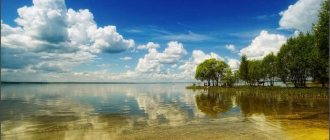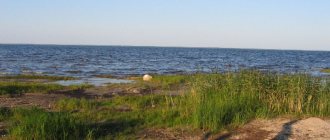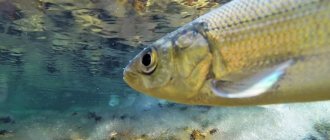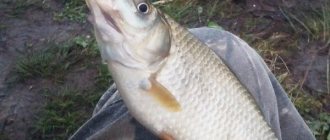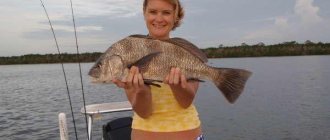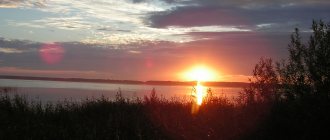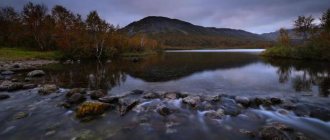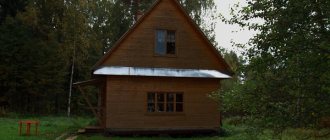How the lake came into being, its geography and description
Glubokoye is a rather complex body of water, about which there are many legends. There are a lot of theories about its origin, but you can often hear about the glacial, meteorite or karst version of its origin. Scientists are trying to prove that a melted glacier filled a deep depression in the Smolensk-Moscow Upland, which was the beginning of the existence of the described object.
The glacial hypothesis has a number of weaknesses. The bottom line is that all glacial objects are prone to aging associated with the presence of silt deposits and the encroachment of peat bogs. These factors are completely absent here, so this is just a version.
Modern experts are more inclined to the meteorite theory, but it has also not been proven. Once every few decades, all the liquid and living creatures disappeared here, and then appeared again. Scientists cannot explain the reason for this phenomenon.
The deep lake in the Ruza region is considered a kind of center of pilgrimage for tourists - its water is distinguished by various miraculous and healing qualities. Lovers of wanderings put up tents in the middle of the forest, almost next to the surface of the lake, rent a room in neighboring villages just to swim here and get a charge of positive energy or get rid of various diseases.
The mystery of the origin
Deep Lake (Moscow region) is a rather unusual body of water. There are several theories about its origin. The most frequently heard are glacial, karst and meteorite versions. The literature indicates the glacial origin of the reservoir: melting waters filled the deep depression of the Smolensk-Moscow Upland and gave rise to its existence.
However, some facts do not fit with this theory. For example, all glacial lakes have the property of aging. This occurs due to silt deposits and the encroachment of peat bogs. However, here all these factors are powerless, and the secret of the lake has not yet been revealed. The meteorite theory seems more likely, but there is also no evidence in its favor.
Features and nature of the reservoir
The area of Lake Glubokoe is up to 59 hectares, and its depth exceeds 32 m. In the 70s. The water here was slightly yellowish, but after the construction of drainage canal systems it became much cleaner. This improvement also affected the water level - it dropped significantly.
The banks are overgrown with reeds and other types of plants. The southern side shows signs of marshland. In spring, the lake is filled with melted water, giving it a yellowish tint that disappears over time. The northern shoreline of the lake is optimal for fishing here, as it has a relatively flat bottom.
At great depths, the temperature rarely rises above +6 degrees, so schools of fish tend to stay in the coastal zone. The spacious bay in this case becomes a suitable point for spawning. The reed thickets in it attract young animals, and predators also follow the small fish. There are practically no vessels on the lake, not counting service ones, and in summer fishing is possible from rafts or rubber boats.
Hydrography
Lake Glubokoe is located among the dense, swampy forests of the Ruza urban district. Its area is about 59 hectares (according to other sources - 56 hectares[3] and 48 hectares[5]), the depth reaches 32 meters[6]. The water is clean. Until the 1970s, the water in the lake was yellowish in color, but after the construction of a system of drainage canals located around the lake, the water became clear, but the water level in the lake decreased. Blue clays and boulders were found at the bottom of the lake, which indicate its glacial origin. A characteristic feature of the lake is its swampy shores. The Malaya Istra River flows out of the lake. The temperature in the bottom layers of water is very constant throughout the year and ranges from 4 to 6 °C.
The lake houses the hydrobiological station of the Institute of Ecology and Evolution. A. N. Severtsov RAS.
How else can you relax here?
There are two bases near the lake shores, where it is easy to leave things or spend the night, purchase a fishing permit or rent a boat. While relaxing here, you can visit an amazing place - the Church of the Smolensk Icon of the Mother of God in the village of Novogorbovo. It was erected in 1758.
There is also a monument to the massacre of the inhabitants of this village during the Second World War. At an insignificant distance you will also find several camp sites and cottages, and a hotel. Everywhere, vacationers will be received as kindly and welcomingly as possible - this is confirmed by the reviews of travelers who have already vacationed here.
How to get there (get there)?
You can get to the village of Novogorbovo by buses No. 21 and No. 26, which go from Ruza, Kolyubakino and Tuchkovo.
It’s easy to get to Glubokoye Lake by car like this:
Note to tourists
- Address: s. Novogorbovo, Ruzsky district, Moscow region, Russia.
- GPS coordinates: 55.753516, 36.504362.
Fishing on Glubokoye Lake will give you many different experiences. This is evidenced by numerous reviews and photos of tourists with their catch, but it’s best to see this in person. Come and then write about how you spent your holiday here, what you liked and what you didn’t. In conclusion - a video clip, enjoy watching!
How to get there
Access to this water body is possible at the beginning of winter with little snow and during dry periods along several routes. The first is from the city of Zvenigorod, passing the villages of Shikhovo and Rybushkino, Kariyskoye and Faustovo, as well as Andreevskoye. This path will be about thirty kilometers. The second is by bus from the city of Zvenigorod to the village of Gerasimovo, and then about six kilometers on foot. Another possible route is past Tuchkovo and Kulubakino, through the village of Novo-Gorbovo and then about five kilometers along a dirt road.
Deep lake
Lake Glubokoe is located in the Leningrad region and is the largest in the center of the Karelian Isthmus. The reservoir is part of the Vuoksa River basin and is connected to it by the Cold Stream. It is also known that the Ostrovyanka River flows into Lake Glubokoe from the western side. Lake Glubokoe in the Leningrad region is the most popular among fishermen - there is quite a lot of fish here and there are all the conditions for a good catch. In addition, despite the rather wild conditions, vacationers sometimes come here to spend time in the lap of nature. The lake shore is quite suitable for camping, and a picturesque forest is within walking distance.
Lake Glubokoe in the Leningrad region on Google panorama
Hydrography[ | ]
Lake Glubokoe is located among the dense, swampy forests of the Ruza urban district. Its area is about 59 hectares (according to other sources - 56 hectares[3] and 48 hectares[5]), the depth reaches 32 meters[6]. The water is clean. Until the 1970s, the water in the lake was yellowish in color, but after the construction of a system of drainage canals located around the lake, the water became clear, but the water level in the lake decreased. Blue clays and boulders were found at the bottom of the lake, which indicate its glacial origin. A characteristic feature of the lake is its swampy shores. The Malaya Istra River flows out of the lake. The temperature in the bottom layers of water is very constant throughout the year and ranges from 4 to 6 °C.
The lake houses the hydrobiological station of the Institute of Ecology and Evolution. A. N. Severtsov RAS.
Nature and water
It is reported that Lake Glubokoe in the Leningrad region has the shape of a “pear” and is located in a depression. The slopes around are quite gentle. The length of the lake is just over 12 kilometers, and the width at its largest point is about 6 meters. The total surface area of the lake is 37.9 square kilometers.
Lake Glubokoe is quite shallow - the average depth does not exceed 5 meters. According to travelers, the water in the lake is green, and the reservoir itself is quite overgrown and blooming. Arriving here, you will notice a long strip of reeds and reeds. The greatest concentration of this vegetation is in the north-west of the reservoir. In addition to reeds, other vegetation can be observed on Lake Glubokoe, for example, water buttercups, egg capsules and water lilies.
Sections of the coastline have different surfaces. For example, on the northern shore of Glubokoye Lake the coast is sandy with small admixtures of stones, and on the south the beach is completely rocky. In the more western parts of Lake Glubokoe you can see swamps - the lake is fed precisely by them. In summer, the reservoir warms up quite quickly, so on the hottest day you can find the water temperature here at +25°C.
Lake Glubokoe (Ruzsky district): fishing
Even in the summer heat at great depths, the water temperature in the reservoir does not exceed six degrees Celsius. As a result, in the warm season the fish prefers to stay in the coastal zone. That is why the wide bay on the northern side of the lake, which is five meters deep, is a spawning and feeding area for many species of fish.
In addition, the presence of reeds on the shores of the bay attracts young animals here. And predators come after him. The deep lake and the bay are separated by an underwater edge. You can find it by fishing vertically using a heavy spoon. The fish here prefer to stay on underwater slopes, which are located at a distance of 18-20 meters from the shore.
The lake bottom is dense and there is very little vegetation. Due to the protection of the coast and the terrain, the winds here do not create large accelerating waves, and the surf does not force the fish to move away from the coastal zone. Only service boats are allowed; in summer, fishing from rubber boats and rafts is allowed. This is Lake Glubokoe!
Fishing here attracts with its diversity. You can catch perch and pike with mugs or fish for roach and bream in a baited area. In calm, windless weather, from a boat without anchoring using the rafting method, you can enjoy plumb fishing with a jig or spoon. The gear is best used for deep sea fishing. In addition, coastal fishing with a long float rod or bottom tackle has proven itself well.
Fishing and recreation on Lake Glubokoe in the Leningrad region
Fishing is considered the most popular leisure activity on Lake Glubokoe - the reservoir is inhabited by many inhabitants. According to reviews from tourists, Glubokoye is home to bream, ruffe, perch, ide, pike, as well as bleak and roach. The most fishing spots of the reservoir are located in the northwestern part, near the islands. The southern shore of the reservoir can also produce good catches. According to fishermen, the ideal set of gear for fishing on Glubokoe is a float rod, spinning rod and girders.
In addition to fishing, the coast of Lake Glubokoe is also used for regular camping. In the summer, tourists come here quite often. The northern and southern shores are great for a beach holiday. Despite the fact that the coverage on the beaches of Lake Glubokoe is not very uniform, they are still popular among residents of the Leningrad region. According to reviews, entering the water in some areas may not be smooth enough, so you should be careful. For those tourists who consider comfort the most important aspect of their holiday, there are several guest cottages near the beach. It is reported that local recreation centers have a fairly well-developed infrastructure - sometimes holidays and events are held here.
Fishing on Lake Glubokoe
Lake Glubokoe is popular among fishermen, even though quite a lot of people live on its shores. People come here for fishing both in summer and winter. The following types of fish are found here: pike, roach, perch, bleak, burbot, bream, ruff; ide and whitefish are less common.
It is believed that the best places for fishing are the straits between the islands, as well as the southeastern part of the lake. However, you can fish in any part of the waters of Lake Glubokoe. For fishing, it is recommended to have a boat and an echo sounder.
In general, this is a fairly interesting body of water for fishing; the presence of settlements along the banks and easy accessibility are compensated by the size of the lake. Although it is worth noting that Glubokoe is still not the best lake for fishing in the Leningrad region and even in the Vyborg region, there are more interesting places.
Video:
Why it's worth a visit
Most often, tourists come to Glubokoe Lake for a comfortable vacation or productive fishing. It is possible not only to implement both types of leisure here, but also to combine them. The shores of the reservoir are excellent for a beach holiday, and some of the areas of the lake are very fishy. According to reviews from tourists, finding a reservoir is not so difficult, so there are no problems with transport accessibility. It is also worth noting that very picturesque views open up from here - you can take vivid photographs.
How to get to Deep Lake in the Vyborg region
The railway stations closest to the lake, Kirillovskoye and Leipyasuo, are located in neighboring settlements. A walk from them to the lake can take about two hours, so tourists rarely prefer this option. As a rule, people come to Lake Glubokoe by private car. Navigator coordinates: 60.555776, 29.340045.
Car route from St. Petersburg to Glubokoye Lake
Lake Glubokoe in the Leningrad region on video
